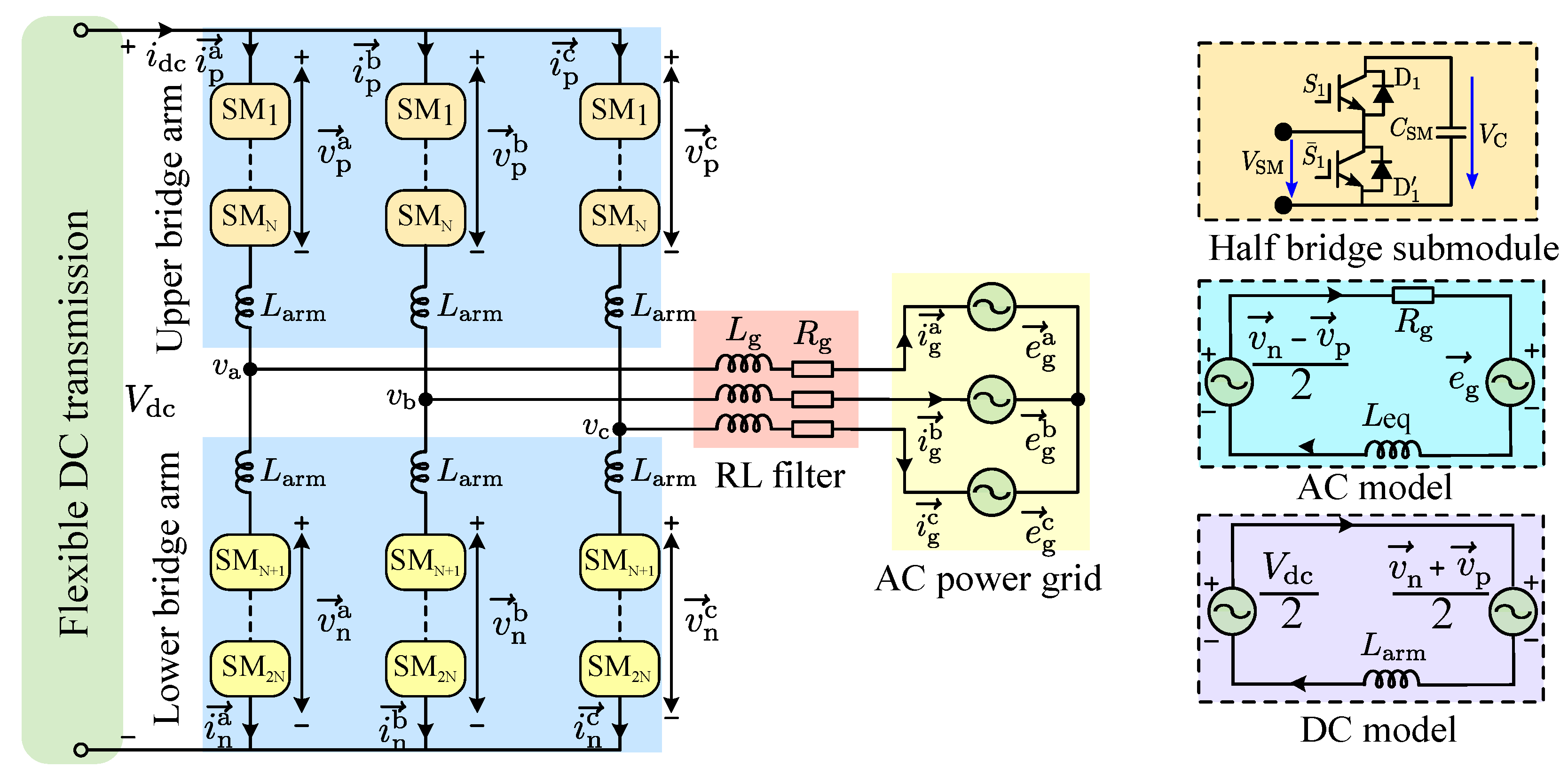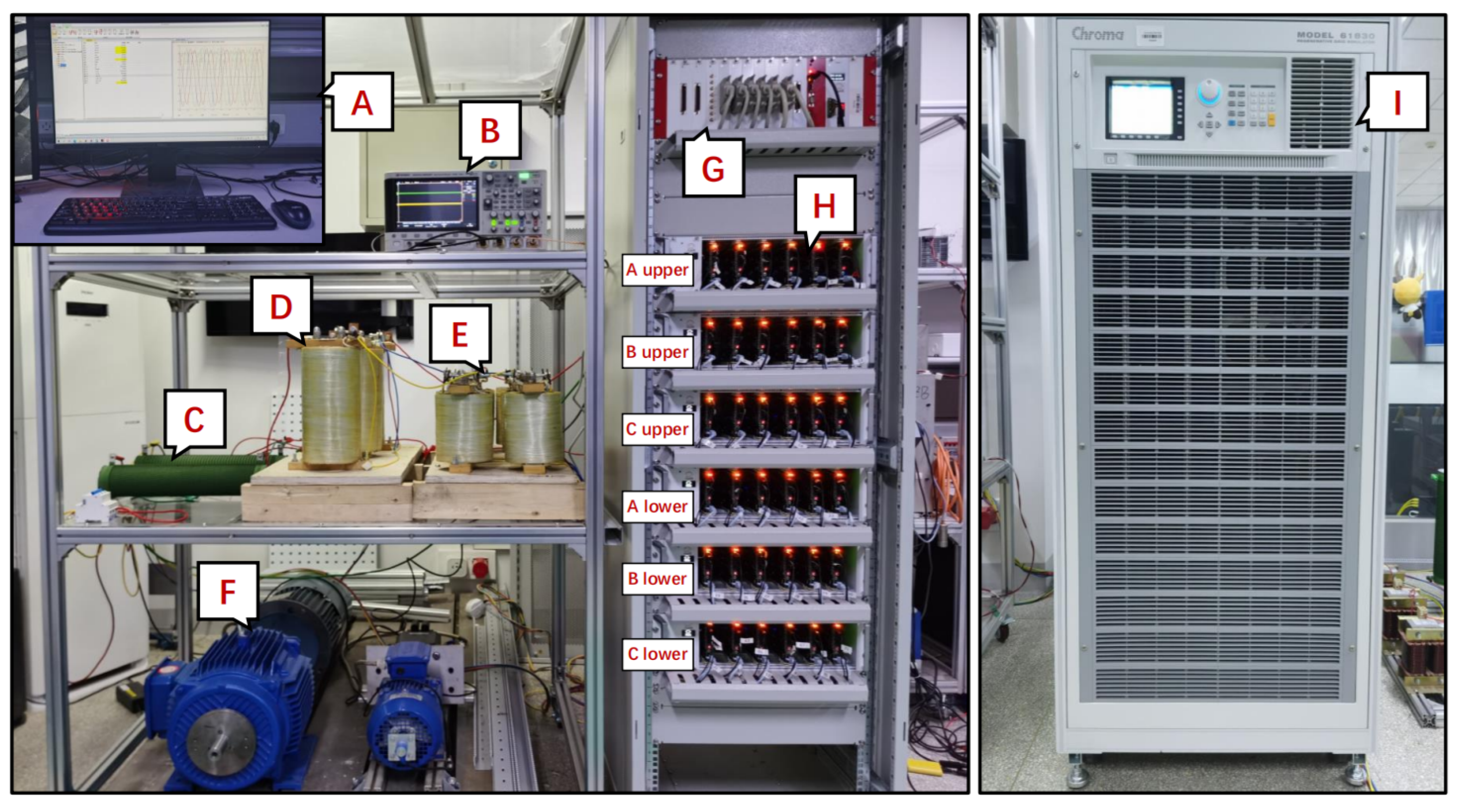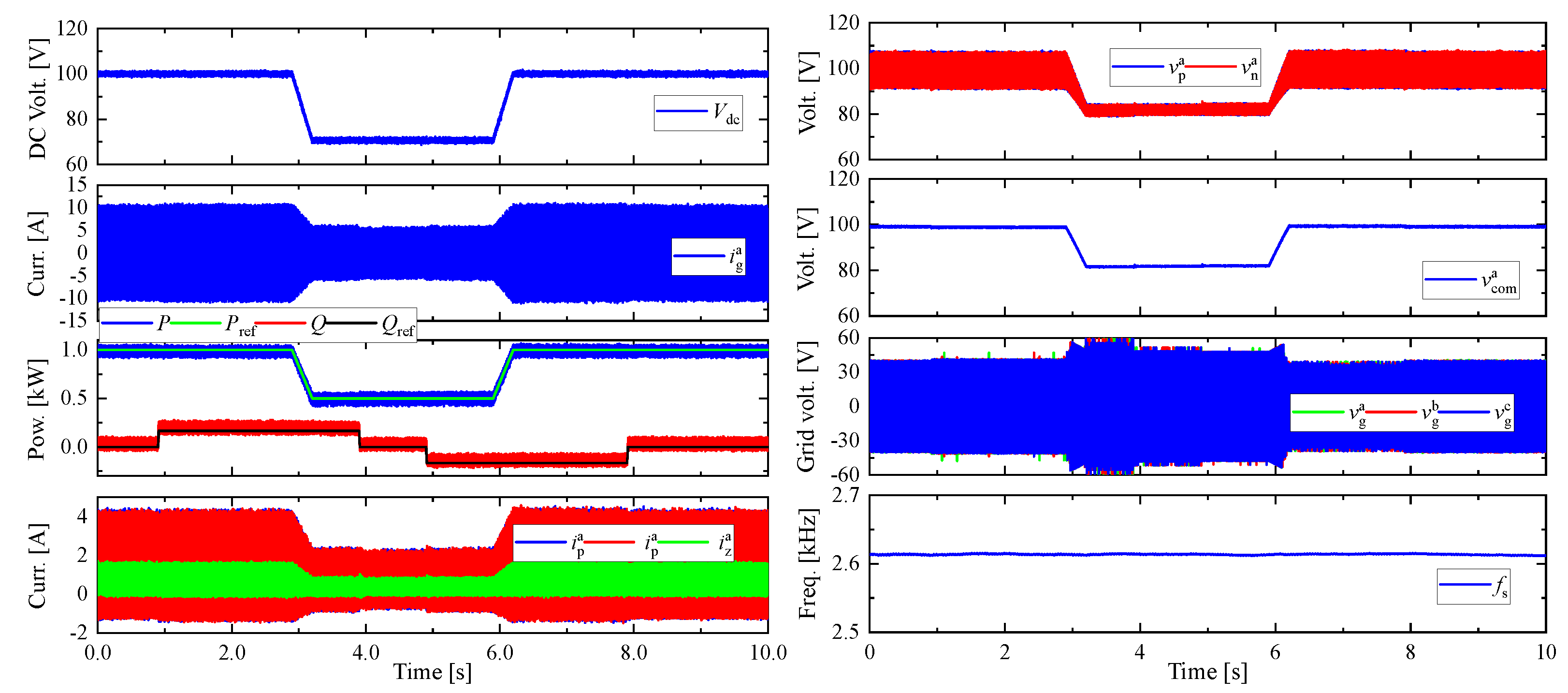Predictive Control of Modular Multilevel Converters: Adaptive Hybrid Framework for Circulating Current and Capacitor Voltage Fluctuation Suppression †
Abstract
1. Introduction
- 1.
- To solve the existing issue of the high computational requirement in [13], this work proposes an adaptive MPC method. It dynamically adjusts the number of candidate combinations by distinguishing the operation modes between steady and transient states, significantly reducing the computational burden while maintaining the fast dynamics during transient states;
- 2.
- To balance capacitor voltage and circulating current, this work developed an improved hybrid control framework, which uses an MPC to control the current and two PR controllers to control the circulating current and capacitor voltage. Unlike the method in [17], the output of the PR controller is used to adjust the number of inserted SMs instead of modifying the switching signals, which maintains the single-interval, single-switching characteristics of the MPC and hence reduces the total switching frequency;
- 3.
- A simulation and experimental results verified the excellent control performance of the proposed method;
2. System Model of Grid-Connected MMC
3. Classical Simplified Optimization Hybrid Predictive Control Framework
3.1. Classical Simplified Optimization MPC
3.2. Classical Quasi-PR Circulating Current and Capacitor Voltage Fluctuation Suppression Controller
4. Proposed Adaptive Hybrid Predictive Control Framework
4.1. The Proposed Adaptive MPC
| Algorithm 1 State judgment in phase current control. |
|
4.2. Proposed PR Circulating Current and Capacitor Voltage Fluctuation Suppression Controller
| Algorithm 2 State judgment in circulating current control. |
|
| Algorithm 3 State judgment in capacitor voltage control. |
|
5. Simulation and Experimental Verification
5.1. Overall Validation of the Proposed Method
5.2. Dynamic State Control Performance
5.3. Steady-State Control Performance
5.4. Comparison of Circulating Current and Capacitor Voltage Fluctuation Performance
6. Conclusions
Author Contributions
Funding
Data Availability Statement
Conflicts of Interest
References
- Li, Y.; Liu, D.; Kish, G.J. A Dual-MMC Chain-Link Structure for Multifrequency Power Transfer. IEEE Trans. Power Electron. 2022, 37, 14601–14614. [Google Scholar] [CrossRef]
- Sun, Y.; Li, Z.; Zhang, Y.; Li, Y.; Zhang, Z. A Time-Domain Virtual-Flux Based Predictive Control of Modular Multilevel Converters for Offshore Wind Energy Integration. IEEE Trans. Energy Convers. 2022, 37, 1803–1814. [Google Scholar] [CrossRef]
- Li, S.; Chen, W.; Yin, X.; Chen, D.; Teng, Y. A Novel Integrated Protection for VSC-HVDC Transmission Line Based on Current Limiting Reactor Power. IEEE Trans. Power Delivery. 2020, 35, 226–233. [Google Scholar] [CrossRef]
- Yaramasu, V.; Wu, B. Model Predictive Decoupled Active and Reactive Power Control for High-Power Grid-Connected Four-Level Diode-Clamped Inverters. IEEE Trans. Ind. Electron. 2014, 61, 3407–3416. [Google Scholar] [CrossRef]
- Yaramasu, V.; Wu, B.; Chen, J. Model-Predictive Control of Grid-Tied Four-Level Diode-Clamped Inverters for High-Power Wind Energy Conversion Systems. IEEE Trans. Power Electron. 2014, 29, 2861–2873. [Google Scholar] [CrossRef]
- Laib, A.; Krim, F.; Talbi, B.; Sahli, A. A predictive control scheme for large-scale grid-connected PV system using high-level NPC inverter. Arab. J. Sci. Eng. 2020, 45, 1685–1701. [Google Scholar] [CrossRef]
- Perez, M.A.; Rodriguez, J.; Fuentes, E.J.; Kammerer, F. Predictive Control of AC–AC Modular Multilevel Converters. IEEE Trans. Ind. Electron. 2012, 59, 2832–2839. [Google Scholar] [CrossRef]
- Gutierrez, B.; Kwak, S.-S. Modular Multilevel Converters Controlled by Model Predictive Control With Reduced Calculation Burden. IEEE Trans. Power Electron. 2018, 33, 9176–9187. [Google Scholar] [CrossRef]
- Liu, X.; Qiu, L.; Fang, Y.; Peng, Z.; Wang, D. Finite-Level-State Model Predictive Control for Sensorless Three-Phase Four-Arm Modular Multilevel Converter. IEEE Trans. Power Electron. 2020, 35, 4462–4466. [Google Scholar] [CrossRef]
- Zhang, S.; Madawala, U.K. A Hybrid Model Predictive Multilayer Control Strategy for Modular Multilevel Converters. IEEE Trans. Emerg. Sel. Top. Power Electron. 2019, 7, 1002–1014. [Google Scholar] [CrossRef]
- Poblete, P.; Neira, S.; Aguilera, R.P.; Pereda, J.; Pou, J. Sequential Phase-Shifted Model Predictive Control for Modular Multilevel Converters. IEEE Trans. Energy Convers. 2021, 36, 2691–2702. [Google Scholar] [CrossRef]
- Vatani, M.; Bahrani, B.; Saeedifard, M.; Hovd, M. Indirect Finite Control Set Model Predictive Control of Modular Multilevel Converters. IEEE Trans. Smart Grid 2015, 6, 1520–1529. [Google Scholar] [CrossRef]
- Sun, Y.; Li, Z.; Zhang, Z.; Dragicevic, T.; Rodriguez, J. Predictive Power Control of Modular Multilevel Converter for Wind Energy Integration via HVDC. In Proceedings of the 2020 IEEE 11th International Symposium on Power Electronics for Distributed Generation Systems (PEDG), Dubrovnik, Croatia, 8 September–1 October 2020; pp. 334–339. [Google Scholar]
- Gong, Z.; Dai, P.; Yuan, X.; Wu, X.; Guo, G. Design and Experimental Evaluation of Fast Model Predictive Control for Modular Multilevel Converters. IEEE Trans. Ind. Electron. 2016, 63, 3845–3856. [Google Scholar] [CrossRef]
- Wang, J.; Wang, P. Power Decoupling Control for Modular Multilevel Converter. IEEE Trans. Power Electron. 2018, 33, 9296–9309. [Google Scholar] [CrossRef]
- Sun, Y.; Li, Z.; Zhang, Z. Hybrid predictive control with simple linear control based circulating current suppression for modular multilevel converters. CES Trans. Electr. Mach. Syst. 2019, 3, 335–341. [Google Scholar] [CrossRef]
- Sun, Y.; Zhang, Z.; Wang, Y.; Li, Z.; Rodriguez, J. Robust Predictive Control of Grid-Tied Modular Multilevel Converters for HVDC Systems With Virtual-Flux Based Online Inductance Estimation. IEEE Trans. Power Deliv. 2022, 37, 3189–3199. [Google Scholar] [CrossRef]
- Zeni, L.; Eriksson, R.; Goumalatsos, S.; Altin, M.; Sørensen, P.; Hansen, A.; Kjær, P.; Hesselbæk, B. Power Oscillation Damping From VSC–HVDC Connected Offshore Wind Power Plants. IEEE Trans. Power Deliv. 2016, 31, 829–838. [Google Scholar] [CrossRef]
- Ilves, K.; Norrga, S.; Harnefors, L.; Nee, H.-P. On Energy Storage Requirements in Modular Multilevel Converters. IEEE Trans. Power Electron. 2014, 29, 77–88. [Google Scholar] [CrossRef]
- Chen, X.; Liu, J.; Song, S.; Ouyang, S. Circulating Harmonic Currents Suppression of Level-Increased NLM Based Modular Multilevel Converter With Deadbeat Control. IEEE Trans. Power Electron. 2020, 35, 11418–11429. [Google Scholar] [CrossRef]
- Li, J.; Jin, X.; Wu, X.; Zhang, J.; Wu, W. Strategy and Application of Reducing Capacitor Voltage Ripples in Modular Multilevel Converters. Proc. CSEE 2016, 36, 1892–1899. [Google Scholar]
- Meng, J.; Song, Q.; Sun, Q.; Li, X.; Xu, S.; Rao, H. Optimization Control Strategy of Capacitor Voltage for Modular Multilevel Converter Based on Mathematical Analysis of Circulating Current. High Volt. Eng. 2019, 45, 882–889. [Google Scholar]
- Wang, J.; Han, X.; Ma, H.; Bai, Z. Analysis and Injection Control of Circulating Current for Modular Multilevel Converters. IEEE Trans. Ind. Electron. 2019, 66, 2280–2290. [Google Scholar] [CrossRef]
- Moon, J.-W.; Park, J.-W.; Kang, D.-W.; Kim, J.-M. A Control Method of HVDC-Modular Multilevel Converter Based on Arm Current Under the Unbalanced Voltage Condition. IEEE Trans. Power Electron. 2015, 30, 529–536. [Google Scholar] [CrossRef]
- Li, R.; Fletcher, J.E.; Williams, B.W. Influence of third harmonic injection on modular multilevel converter -based high-voltage direct current transmission systems. IET Gener. Transm. Distrib. 2016, 10, 529–536. [Google Scholar] [CrossRef]
- Fehr, H.; Gensior, A. Improved Energy Balancing of Grid-Side Modular Multilevel Converters by Optimized Feedforward Circulating Currents and Common-Mode Voltage. IEEE Trans. Power Electron. 2018, 33, 10903–10913. [Google Scholar] [CrossRef]
- Dong, P.; Lyu, J.; Cai, X. Optimized Design and Control for Hybrid MMC With Reduced Capacitance Requirements. IEEE Access 2018, 6, 51069–51083. [Google Scholar] [CrossRef]
- Li, J.; Zhang, Z.; Li, Z.; Sun, Y.; Rodriguez, J. An Efficient Dynamic Sequential Predictive Control of Module Multilevel Power Converters. In Proceedings of the 2023 IEEE International Conference on Predictive Control of Electrical Drives and Power Electronics (PRECEDE), Wuhan, China, 16–19 June 2023; pp. 1–6. [Google Scholar]
- Han, Y. Research on Capacitance Voltage Fluctuation and Circulation Suppression Method of Modular Multi-level Convert. Master’s Thesis, Liaoning Technical University, Fuxin, China, 2021. [Google Scholar]
- Wang, S.; Liang, J.; Ekanayake, J. Optimised topology design and comparison for offshore transmission. In Proceedings of the 2012 47th International Universities Power Engineering Conference (UPEC), Uxbridge, UK, 4–7 September 2012; pp. 1–6. [Google Scholar]









| Parameter | Simulation Value | Experiment Value |
|---|---|---|
| DC-link voltage | 300 V | 100 V |
| Number of SMs in arm | 10 | 4 |
| SM capacitor | 0.5 mF | 1.64 mF |
| Arm inductance | 5 mH | 5 mH |
| Grid resistance | 0.5 | 5 |
| Grid inductance | 10 mH | 10 mH |
| Sample time | 100 s | 100 s |
| Grid voltage | 60 V | 40 V |
| Grid frequency | 50 Hz | 50 Hz |
| Method | Sequential Optimization MPC | Simplified Optimization MPC | Proposed Adaptive MPC |
|---|---|---|---|
| Number of calculations | 14 | 6 | 6–10, average 7.09 |
| Response time | 1.1 ms | 2.5 ms | 1.3 ms |
| Computing time (<100 s) | 81 s | 56 s | 62 s |
| Switching frequency | 2593 Hz | 2576 Hz | 2591 Hz |
| Parameter | Hybrid Circulating Current Control Framework | Simplified Optimization Hybrid Control Framework | Proposed Adaptive Hybrid Control Framework |
|---|---|---|---|
| Peak value of | 1.19 A | 1.42 A | 1.26 A |
| RMS value of | 0.67 A | 0.92 A | 0.81 A |
| Peak value of | 32.61 V | 31.81 V | 31.32 V |
| Minimum value of | 27.45 V | 27.24 V | 27.07 V |
| RMS value of | 30.02 V | 29.96 V | 29.39 V |
| Amplitude of | 5.16 V | 4.57 V | 4.25 V |
| Peak value of | 30.42 V | 30.04 V | 30.00 V |
| Minimum value of | 29.44 V | 29.89 V | 29.92 V |
| RMS value of | 30.01 V | 29.95 V | 29.95 V |
| Maximum deviation in | 0.57 V | 0.09 V | 0.05 V |
| Computing time (<100 s) | 57 s | 52 s | 53 s |
| Switching frequency | 2901 Hz | 2896 Hz | 2614 Hz |
Disclaimer/Publisher’s Note: The statements, opinions and data contained in all publications are solely those of the individual author(s) and contributor(s) and not of MDPI and/or the editor(s). MDPI and/or the editor(s) disclaim responsibility for any injury to people or property resulting from any ideas, methods, instructions or products referred to in the content. |
© 2023 by the authors. Licensee MDPI, Basel, Switzerland. This article is an open access article distributed under the terms and conditions of the Creative Commons Attribution (CC BY) license (https://creativecommons.org/licenses/by/4.0/).
Share and Cite
Li, J.; Zhang, Z.; Li, Z.; Babayomi, O. Predictive Control of Modular Multilevel Converters: Adaptive Hybrid Framework for Circulating Current and Capacitor Voltage Fluctuation Suppression. Energies 2023, 16, 5772. https://doi.org/10.3390/en16155772
Li J, Zhang Z, Li Z, Babayomi O. Predictive Control of Modular Multilevel Converters: Adaptive Hybrid Framework for Circulating Current and Capacitor Voltage Fluctuation Suppression. Energies. 2023; 16(15):5772. https://doi.org/10.3390/en16155772
Chicago/Turabian StyleLi, Junda, Zhenbin Zhang, Zhen Li, and Oluleke Babayomi. 2023. "Predictive Control of Modular Multilevel Converters: Adaptive Hybrid Framework for Circulating Current and Capacitor Voltage Fluctuation Suppression" Energies 16, no. 15: 5772. https://doi.org/10.3390/en16155772
APA StyleLi, J., Zhang, Z., Li, Z., & Babayomi, O. (2023). Predictive Control of Modular Multilevel Converters: Adaptive Hybrid Framework for Circulating Current and Capacitor Voltage Fluctuation Suppression. Energies, 16(15), 5772. https://doi.org/10.3390/en16155772






